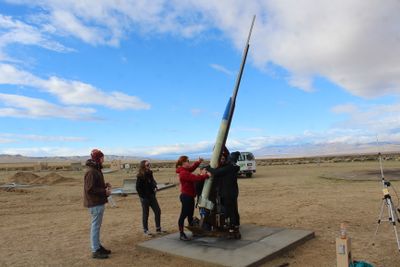Olympus 2019
Olympus 2019 was the third SSI team to compete in the Intercollegiate Rocketry Engineering Competition, succeeding IREC 2018. The rocket featured a compact avionics bay, a redesigned recovery system, a fiberglass airframe with a carbon fiber fin lay-up, and a protein crystallography payload. Currently, a liquid propulsion system is in development, and may be the motor for the final iteration of the rocket, though this is still undecided. This liquid motor was a continuation of the prior year's Helios project, and used many of the same design principles.
Overview
Goals and Requirements
The goal of the rocket design was to be capable of delivering an 8.8 pound payload to an altitude of 30,000 feet while employing as much student innovation as possible.
System Design
Unlike the year before, the Olympus 2019 rocket used five-inch diameter body tubing instead of four-inch tubing. This choice was driven by the design of the tanks for the liquid propulsion system.
Avionics
The avionics system consisted of multiple custom printed circuit board assemblies (PCBAs), which used direct board-to-board interconnects to eliminate the use of wires.
The main boards in the avionics system were:
- SpaceSalmon, a rocket flight computer developed by Tim Vrakas, both for Olympus and for Spaceshot.
- COTS Carrier, a board designed by Shreya Ravi to interface a Stratologger commercial altimeter to the rest of the avionics system.
- RF Carrier, a board designed by Albert Landa which was the interface between the avionics bay, the GPS module, and the S6C long-distance radio.
- Bulkhead Board, the interface between the avionics bay and the e-match connectors, designed by Jainil Sutaria.
Recovery
Structures
Payload
Propulsion
Staging
Test Launches
Launch 1, March 2nd at FAR
Launch 1 tested all systems at some level of functionality, except for propulsion. The rocket flew to an altitude of approximately 8,000 feet. The main parachute deployed at apogee, which, along with 20 mph winds, caused the rocket to drift 3.6 miles downrange before landing.
